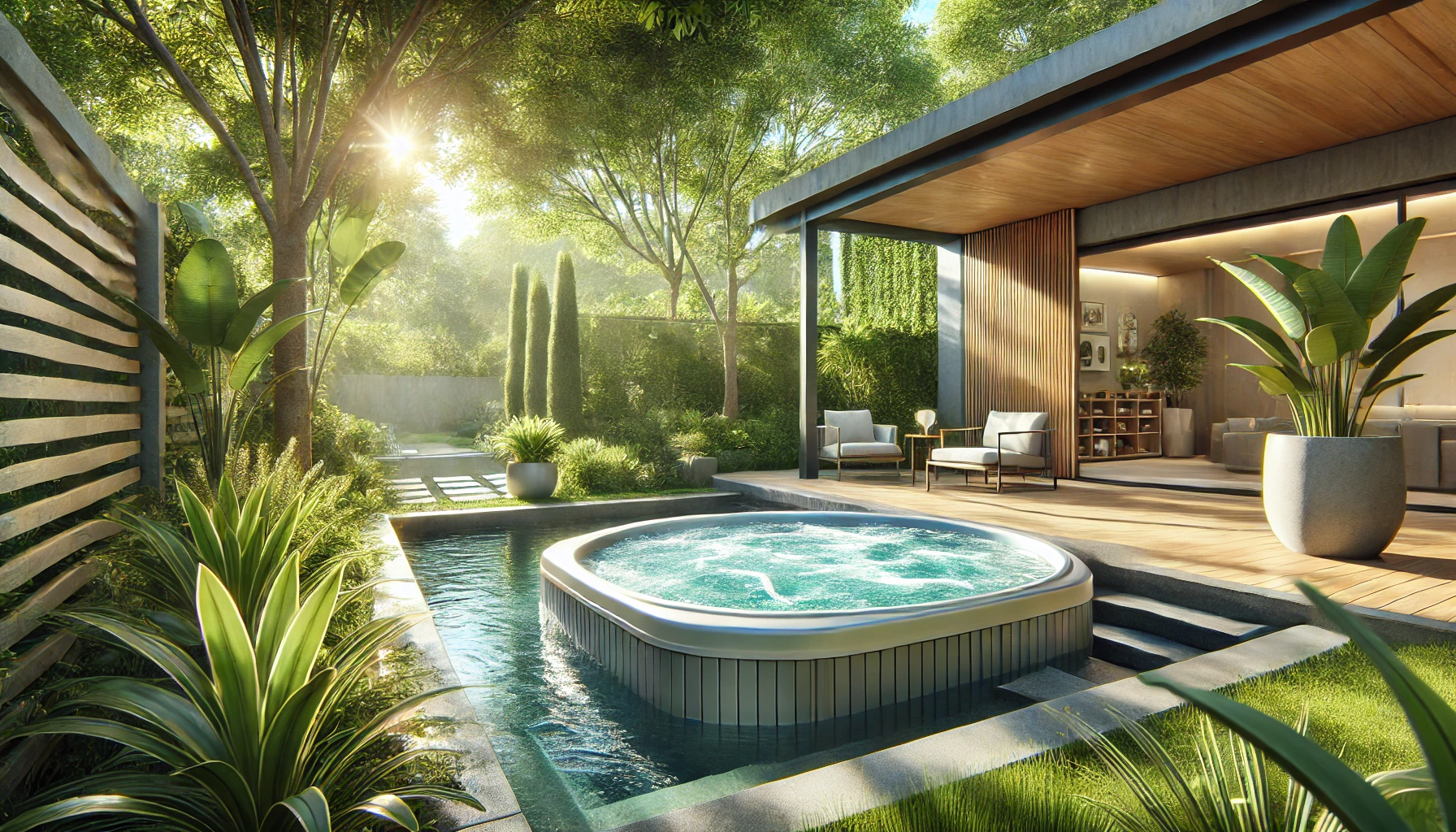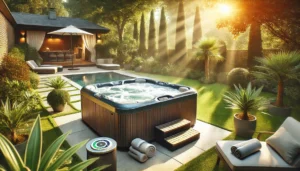Whew! Who knew maintaining a hot tub could be such a chemistry lesson? I sure didn’t when I first got mine.
But let me tell you, understanding and managing your hot tub’s alkalinity is crucial for keeping that backyard oasis in tip-top shape. Trust me, I’ve learned this the hard way!
Did you know that over 60% of hot tub issues are related to improper water chemistry? That’s a stat that really opened my eyes!
So, whether you’re a new hot tub owner or you’ve been soaking for years, getting a handle on alkalinity is key to enjoying your hot tub without the headaches.
In this guide, I’ll walk you through everything I’ve learned about raising alkalinity in a hot tub. From understanding what alkalinity actually is (spoiler: it’s not just a fancy word) to the nitty-gritty of testing and adjusting it.
I’ve made all the mistakes so you don’t have to! So grab a drink (non-alcoholic, of course – safety first when dealing with hot tub chemicals!), and let’s dive into the world of hot tub alkalinity together.
How Do I Raise Alkalinity in a Hot Tub?
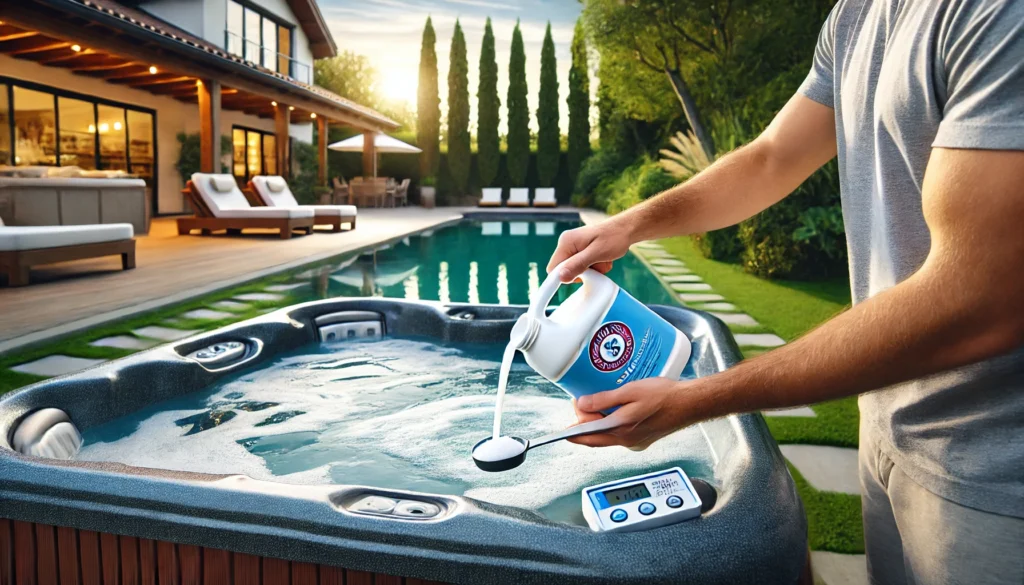
To raise alkalinity in a hot tub, I typically use an alkalinity increaser or baking soda. First, I test the water to determine the current alkalinity level.
Then, I add the appropriate amount of alkalinity increaser or baking soda based on the hot tub’s volume and the desired increase. After adding the chemicals, I run the jets for about 30 minutes to ensure even distribution.
I always retest the water after a few hours to confirm the alkalinity has reached the target range of 80-120 ppm. We’ll explore this process more deeply below, but that’s the gist of how I tackle raising alkalinity in my hot tub.
Understanding Hot Tub Alkalinity
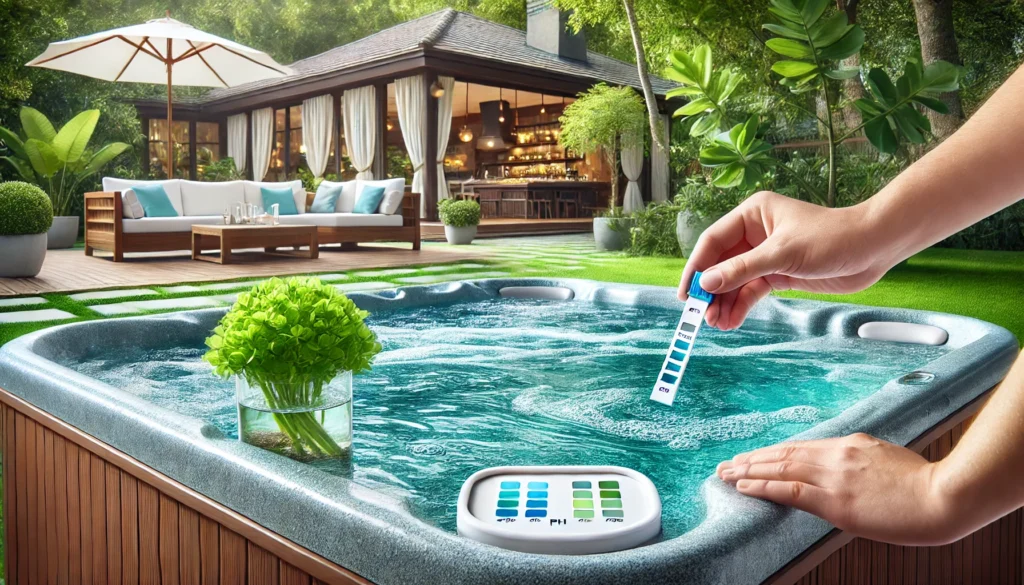
Alright, let’s get down to brass tacks. What the heck is alkalinity anyway?
I remember scratching my head over this one when I first started out. Simply put, alkalinity is your hot tub water’s ability to neutralize acids.
Think of it as your water’s built-in defense system against pH changes. Pretty cool, right?
Now, why should you care about this? Well, let me tell you about the time I ignored my hot tub’s alkalinity.
Big mistake. Huge. I ended up with cloudy water, scaling on my tub’s surface, and my poor filter was working overtime.
Not to mention, my skin felt itchy after every soak. Ugh!
Proper alkalinity is crucial because it helps maintain stable pH levels. It’s like the bouncer at a club, keeping everything in check.
When your alkalinity is in the right range – typically between 80 and 120 parts per million (ppm) – it prevents rapid pH fluctuations. This means your sanitizer (like chlorine) works more effectively, your water stays clear, and your equipment lasts longer.
Win-win-win!
But here’s the kicker – alkalinity and pH aren’t the same thing! I used to mix them up all the time.
While they’re related, alkalinity is about the water’s capacity to neutralize acids, while pH measures how acidic or basic the water actually is. Think of alkalinity as the foundation and pH as the building on top.
You need a solid foundation for everything else to work properly.
So, next time you’re chilling in your hot tub, give a little mental high-five to alkalinity. It’s working hard behind the scenes to keep your soak-time awesome!
Testing Your Hot Tub’s Alkalinity
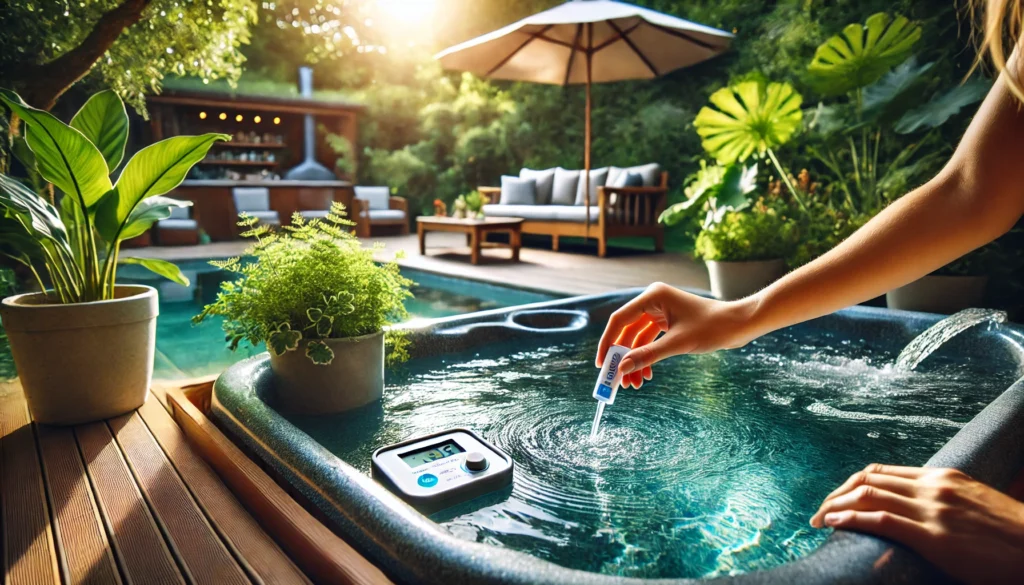
Alright, pop quiz time! How often should you test your hot tub’s alkalinity?
If you’re like me when I first started out, you might think once a month is plenty. Boy, was I wrong!
After some trial and error (emphasis on the error), I’ve learned that testing at least once a week is the way to go. More if you’re using your tub frequently or if it’s outdoors dealing with the elements.
Now, let’s talk testing kits. There are a bunch of options out there, and it can get pretty overwhelming.
Trust me, I’ve been there, staring at the shelves in the pool supply store, feeling like I need a chemistry degree! But here’s what I’ve found works best:
- Test strips: These are my go-to for quick, regular checks. They’re easy to use – just dip, wait, and compare to the color chart.
But be warned, they can be a bit less accurate than other methods.
- Liquid test kits: These are more accurate but take a bit more time. You’ll be adding drops to a water sample and watching for color changes.
It’s like being a mad scientist, but with less dramatic lighting!
- Digital testers: These are the fancy pants of the testing world. They’re super accurate and easy to read, but they can be pricey.
I splurged on one after one too many squinting sessions trying to differentiate between shades of blue on a test strip!
Whichever method you choose, the key is consistency. Use the same type of test each time for the most reliable results.
Now, here’s a pro tip I wish someone had told me earlier: make sure you’re taking your water sample from elbow-deep in the tub, away from any jets or the filter. I used to just scoop from the top and couldn’t figure out why my readings were all over the place!
And for the love of all things bubbly, follow the instructions on your test kit! I once thought I could eyeball the timing and ended up with some seriously wonky readings.
Learn from my mistakes, folks!
Remember, testing isn’t just about alkalinity. You’ll want to check pH, sanitizer levels, and other factors too.
It’s all connected, like a delicate underwater ecosystem. But get the alkalinity right, and you’re well on your way to hot tub bliss!
Methods to Raise Hot Tub Alkalinity
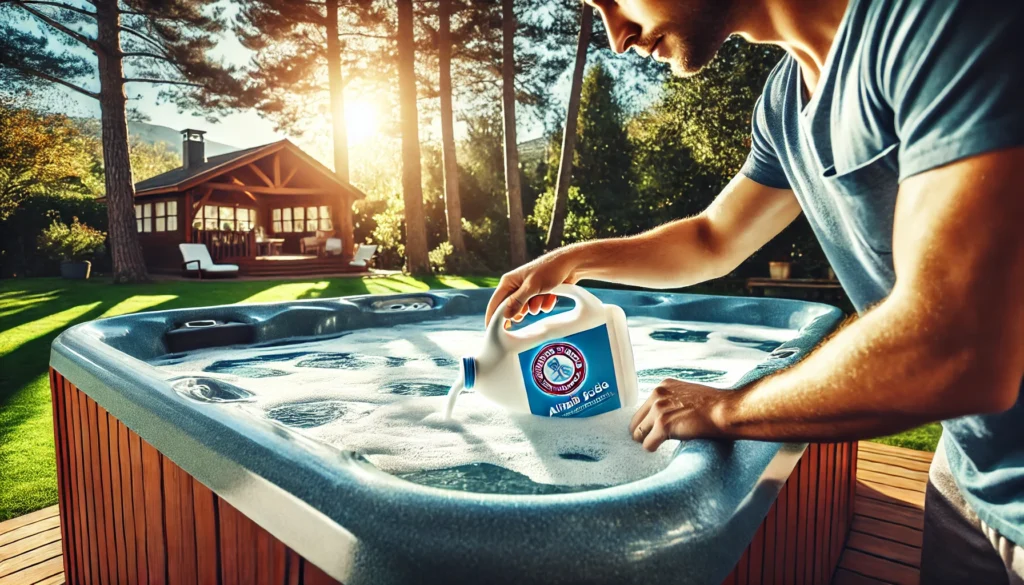
Alright, so you’ve tested your water and found out your alkalinity is lower than a limbo champion. Don’t panic!
I’ve been there, and I’ve got some tried-and-true methods to get those levels back up where they belong.
First up, let’s talk about alkalinity increasers. These are specially formulated products designed to boost your hot tub’s alkalinity.
They’re usually made of sodium bicarbonate or sodium carbonate. When I first started out, I was skeptical about using “chemicals” in my tub.
But trust me, these products are safe when used correctly and can be a real lifesaver!
To use an alkalinity increaser, you’ll need to calculate how much to add based on your tub’s volume and how much you need to raise the alkalinity. Most products come with instructions, but here’s a general rule of thumb: about 1 tablespoon per 100 gallons of water will raise the alkalinity by about 10 ppm.
But always, ALWAYS check the specific instructions for your product!
Now, if you’re more of a DIY type (like I fancy myself to be), you might be interested in a more natural alternative: good old baking soda. Yep, the same stuff you use for baking can help balance your hot tub!
Sodium bicarbonate is the main ingredient in both baking soda and many alkalinity increasers.
Using baking soda is pretty straightforward. You’ll need about 1.5 tablespoons per 100 gallons of water to raise the alkalinity by 10 ppm.
It’s a bit less concentrated than commercial products, so you might need to use a little more.
Whichever method you choose, here’s the most important part: add the increaser or baking soda SLOWLY! I learned this the hard way when I dumped a whole bunch in at once and ended up with cloudy water and off-the-charts alkalinity.
Oops!
Instead, add about half of what you think you need, run the jets for about 30 minutes to circulate the water, then retest. If you need more, repeat the process.
It’s a bit more time-consuming, but trust me, it’s worth it to avoid overcorrecting.
Oh, and one more thing – don’t forget to brush the sides and bottom of your tub after adding any chemicals. This helps prevent scaling and ensures everything dissolves properly.
Remember, raising alkalinity isn’t a one-and-done deal. It’s part of the ongoing maintenance that keeps your hot tub in tip-top shape.
But don’t worry, once you get the hang of it, it’ll become second nature. Before you know it, you’ll be the hot tub guru of your neighborhood!
Common Mistakes When Raising Alkalinity
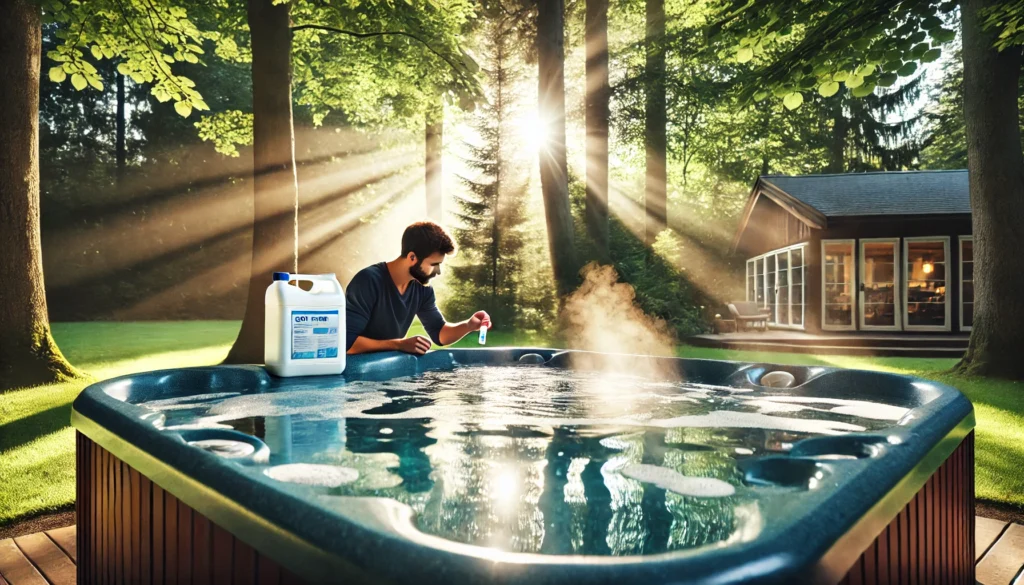
Let me tell you, when it comes to raising alkalinity in a hot tub, I’ve made every mistake in the book. And then some!
But hey, that’s how we learn, right? So, let me save you some headaches and share some of the most common pitfalls I’ve encountered – and how to avoid them.
First up: the “more is better” mentality. Oh boy, was I guilty of this one!
I figured if a little alkalinity increaser was good, a lot must be great, right? Wrong!
Overadding chemicals is a surefire way to throw your water chemistry completely out of whack. I once added so much alkalinity increaser that my pH skyrocketed, and I ended up with cloudy water and scaly buildup.
Not fun!
The fix? Always start with less than you think you need.
You can always add more, but it’s a pain to correct an overcorrection. Trust me on this one!
Another biggie is neglecting other water balance factors. Alkalinity doesn’t exist in a vacuum, folks!
It’s closely tied to pH, and they affect each other. I used to focus solely on alkalinity and couldn’t figure out why my water still wasn’t quite right.
Turns out, I was ignoring my pH levels, which were swinging wildly as a result.
Remember, it’s all connected. When you’re adjusting alkalinity, keep an eye on pH too.
And don’t forget about other factors like calcium hardness and sanitizer levels. It’s like juggling – you’ve got to keep all the balls in the air!
Inconsistent testing and maintenance is another trap I fell into. I’d get all gung-ho about testing for a week or two, then slack off for a month.
Big mistake! By the time I got around to testing again, my water was a mess.
It’s like trying to catch up on a TV show after missing a whole season – you’re lost and everything’s gone crazy!
The solution? Set a regular testing schedule and stick to it.
I now have a reminder on my phone every Sunday to test my hot tub water. It’s become part of my routine, like doing laundry or grocery shopping.
Not the most exciting part of my week, but it keeps my hot tub happy!
Oh, and here’s a rookie mistake I made: testing the water right after adding chemicals. I’d add an alkalinity increaser, test immediately after, and panic when the levels hadn’t changed.
Patience is key here! Give the chemicals time to circulate and do their thing.
Wait at least a few hours, or even overnight, before retesting.
Lastly, don’t forget about the impact of outside factors. I once couldn’t figure out why my alkalinity kept dropping, despite my best efforts.
Turns out, we’d been having a lot of rain, which was affecting my outdoor hot tub’s chemistry. Now I know to test more frequently during rainy seasons or after heavy use.
Remember, maintaining your hot tub is a journey, not a destination. You’ll have ups and downs, but each mistake is a chance to learn.
And before you know it, you’ll be a hot tub chemistry whiz, impressing your friends with your perfect water balance!
Maintaining Optimal Alkalinity Levels
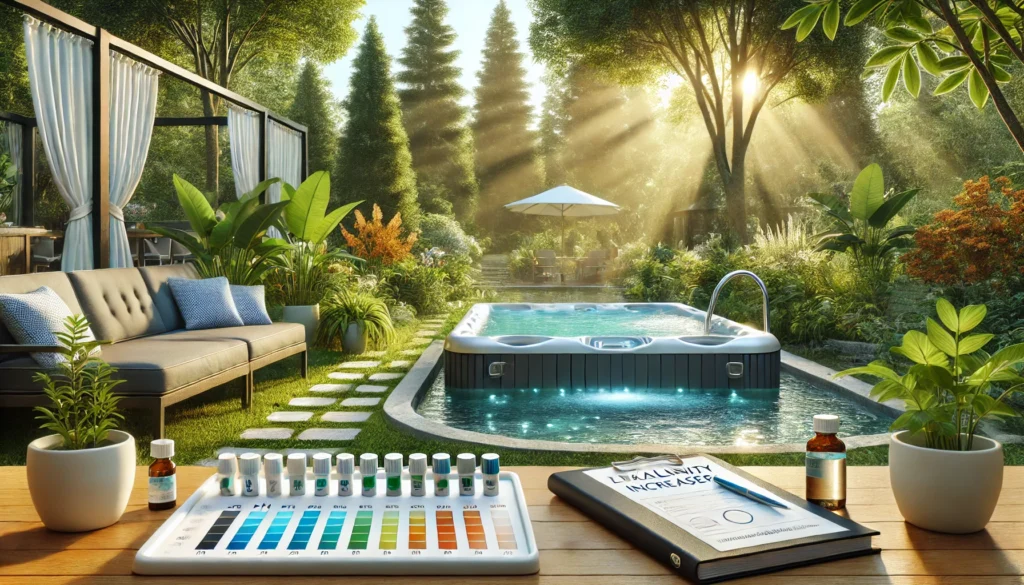
Alright, you’ve successfully raised your hot tub’s alkalinity. Pat yourself on the back!
But don’t get too comfortable – maintaining that perfect balance is an ongoing process. Trust me, I learned this the hard way after letting my guard down and ending up with a hot tub that looked more like a swamp than a relaxing oasis.
So, how do we keep those alkalinity levels in check? First things first: establish a regular testing schedule.
I can’t stress this enough! I now test my hot tub water at least once a week, and more often if I’ve been using it a lot or if there’s been bad weather.
It’s become a Sunday morning ritual for me – coffee in one hand, test strip in the other. Glamorous?
No. Essential? Absolutely!
Now, here’s where things get a bit tricky. Alkalinity and pH are like that couple that’s always bickering – they’re closely related, but they don’t always get along.
I used to get so frustrated trying to balance them both! But here’s what I’ve learned: focus on alkalinity first, then fine-tune the pH.
Why? Well, alkalinity acts as a buffer for pH.
Get your alkalinity right, and your pH will be much more stable. It’s like building a house – you need a solid foundation (alkalinity) before you can worry about the details (pH).
One thing that really helped me was creating a simple log to track my water chemistry over time. Nothing fancy – just a notebook where I jot down the date, alkalinity, pH, and any adjustments I make.
It’s amazing how useful this can be for spotting trends and predicting when you might need to make adjustments.
Now, let’s talk prevention. It’s much easier to maintain good alkalinity than to constantly correct it.
Here are some tips I wish I’d known from the start:
- Be mindful of what you’re adding to your hot tub. Some sanitizers can affect alkalinity, so choose wisely.
- Keep your hot tub covered when not in use. This helps prevent evaporation, which can concentrate minerals and throw off your water balance.
- Shower before you soak! It sounds silly, but the oils, sweat, and products on our bodies can impact water chemistry.
- Don’t forget about your filter! A clean filter helps maintain overall water quality, which in turn helps stabilize alkalinity.
- Consider using a mineral purifier. These can help reduce the amount of chemicals you need to add, making it easier to maintain balanced water.
Oh, and here’s a pro tip: keep some pH increaser and pH decreaser on hand, along with your alkalinity increaser. Sometimes, despite your best efforts, you’ll need to make minor adjustments to keep everything in harmony.
Remember, maintaining optimal alkalinity is like tending a garden. It requires regular attention, but the results are so worth it.
There’s nothing quite like slipping into a perfectly balanced hot tub after a long day. Trust me, your future self will thank you for putting in the effort now!
Conclusion
Whew! We’ve been on quite a journey through the world of hot tub alkalinity, haven’t we? From understanding what alkalinity is, to testing it, raising it, avoiding common mistakes, and maintaining those optimal levels – it’s a lot to take in!
But trust me, mastering this aspect of hot tub care is absolutely worth it.
Remember when I mentioned that stat about 60% of hot tub issues being related to water chemistry? Well, now you’re armed with the knowledge to be on the right side of that statistic!
By keeping your alkalinity in check, you’re not just maintaining clear water – you’re protecting your investment, ensuring your sanitizer works effectively, and creating the perfect environment for relaxation.
Now, I know what you might be thinking: “This sounds like a lot of work!” And sure, at first, it might seem that way. But let me tell you, once you get into the rhythm of regular testing and maintenance, it becomes second nature.
It’s just like any other habit – a little effort up front pays off big time in the long run.
As you put these tips into practice, don’t be discouraged if you don’t get it perfect right away. Hot tub maintenance is as much an art as it is a science, and it takes a bit of time to get to know your particular tub’s quirks.
Be patient with yourself, and remember that even us “experts” are constantly learning!
I encourage you to take what you’ve learned here and make it your own. Maybe you’ll develop a unique system for remembering to test your water, or come up with a clever way to store your testing supplies.
Whatever works for you! And hey, why not share your experiences with other hot tub owners?
We’re all in this together, after all.
Before I sign off, I want to remind you of one crucial point: always prioritize safety when handling hot tub chemicals. Store them properly, follow the instructions carefully, and keep them out of reach of children and pets.
A safe hot tub is a happy hot tub!
So, are you ready to take the plunge into perfect hot tub chemistry? I bet you are!
Remember, maintaining proper alkalinity is key to enjoying your hot tub to the fullest. No more worrying about cloudy water, scale buildup, or ineffective sanitizers.
Just crystal clear, perfectly balanced water ready for you to slip into and let your cares melt away.
Why not start right now? Grab those test strips, check your alkalinity, and take the first step towards hot tub perfection.
And hey, once you’ve got it all figured out, invite some friends over to enjoy your perfectly balanced oasis. Just don’t be surprised if they start coming to you for hot tub advice!
Here’s to many happy, relaxing soaks in your perfectly balanced hot tub. You’ve got this!
